- Home
- Edgar Allan Poe
The Science Fiction of Edgar Allan Poe (Penguin Classics) Page 30
The Science Fiction of Edgar Allan Poe (Penguin Classics) Read online
Page 30
It may be objected, thirdly, that, in general, the peculiar mode of distribution which I have suggested for the atoms, is ‘an hypothesis and nothing more’.
Now, I am aware that the word ‘hypothesis’ is a ponderous sledge-hammer, grasped immediately, if not lifted, by all very diminutive thinkers, on the first appearance of any proposition wearing, in any particular, the garb of a theory. But ‘hypothesis’ cannot be wielded here to any good purpose, even by those who succeed in lifting it – little men or great.
I maintain, first, that only in the mode described is it conceivable that Matter could have been diffused so as to fulfil at once the conditions of radiation and of generally equable distribution. I maintain, secondly, that these conditions themselves have been imposed upon me, as necessities, in a train of ratiocination as rigorously logical as that which establishes any demonstration in Euclid; and I maintain, thirdly, that even if the charge of ‘hypothesis’ were as fully sustained as it is, in fact, unsustained and untenable, still the validity and indisputability of my result would not, even in the slightest particular, be disturbed.
To explain: – The Newtonian Gravity – a law of Nature – a law whose existence as such no one out of Bedlam questions – a law whose admission as such enables us to account for nine-tenths of the Universal phænomena – a law which, merely because it does so enable us to account for these phænomena, we are perfectly willing, without reference to any other considerations, to admit, and cannot help admitting, as a law – a law, nevertheless, of which neither the principle nor the modus operandi of the principle, has ever yet been traced by the human analysis – a law, in short, which, neither in its detail nor in its generality, has been found susceptible of explanation at all – is at length seen to be at every point thoroughly explicable, provided we only yield our assent to — what? To an hypothesis? Why, if an hypothesis – if the merest hypothesis – if an hypothesis for whose assumption – as in the case of that pure hypothesis the Newtonian law itself – no shadow of à priori reason could be assigned – if an hypothesis, even so absolute as all this implies, would enable us to perceive a principle for the Newtonian law – would enable us to understand as satisfied, conditions so miraculously – so ineffably complex and seemingly irreconcileable as those involved in the relations of which Gravity tells us, – what rational being could so expose his fatuity as to call even this absolute hypothesis an hypothesis any longer – unless, indeed, he were to persist in so calling it, with the understanding that he did so, simply for the sake of consistency in words?
But what is the true state of our present case? What is the fact? Not only that it is not an hypothesis which we are required to adopt, in order to admit the principle at issue explained, but that it is a logical conclusion which we are requested not to adopt if we can avoid it – which we are simply invited to deny if we can: – a conclusion of so accurate a logicality that to dispute it would be the effort – to doubt its validity beyond our power: – a conclusion from which we see no mode of escape, turn as we will; a result which confronts us either at the end of an inductive journey from the phænomena of the very Law discussed, or at the close of a deductive career from the most rigorously simple of all conceivable assumptions – the assumption, in a word, of Simplicity itself.
And if here, it be urged, that although my starting-point is, as I assert, the assumption of absolute Simplicity, yet Simplicity, considered merely in itself, is no axiom; and that only deductions from axioms are indisputable – it is thus that I reply:
Every other science than Logic is the science of certain concrete relations. Arithmetic, for example, is the science of the relations of number – Geometry, of the relations of form – Mathematics in general, of the relations of quantity in general – of whatever can be increased or diminished. Logic, however, is the science of Relation in the abstract – of absolute Relation – of Relation considered solely in itself. An axiom in any particular science other than Logic is, thus, merely a proposition announcing certain concrete relations which seem to be too obvious for dispute – as when we say, for instance, that the whole is greater than its part: – and, thus again, the principle of the Logical axiom – in other words, of an axiom in the abstract – is, simply, obviousness of relation. Now, it is clear, not only that what is obvious to one mind may not be obvious to another, but that what is obvious to one mind at one epoch, may be anything but obvious, at another epoch, to the same mind. It is clear, moreover, that what, today, is obvious even to the majority of mankind, or to the majority of the best intellects of mankind, may to-morrow be, to either majority, more or less obvious, or in no respect obvious at all. It is seen, then, that the axiomatic principle itself is susceptible of variation,29 and of course that axioms are susceptible of similar change. Being mutable, the ‘truths’ which grow out of them are necessarily mutable too; or, in other words, are never to be positively depended on as truths at all – since Truth and Immutability are one.
It will now be readily understood that no axiomatic idea – no idea founded in the fluctuating principle, obviousness of relation – can possibly be so secure – so reliable a basis for any structure erected by the Reason, as that idea – (whatever it is, wherever we can find it, or if it be practicable to find it anywhere) – which is irrelative altogether – which not only presents to the understanding no obviousness of relation, either greater or less, to be considered, but subjects the intellect, not in the slightest degree, to the necessity of even looking at any relation at all. If such an idea be not what we too heedlessly term ‘an axiom’, it is at least preferable, as a logical basis, to any axiom ever propounded, or to all imaginable axioms combined: – and such, precisely, is the idea with which my deductive process, so thoroughly corroborated by induction, commences. My Particle Proper is but Absolute Radiation.
To sum up what has been advanced: – As a starting point I have taken it for granted, simply, that the Beginning had nothing behind it or before it – that it was a Beginning in fact – that it was a Beginning and nothing different from a Beginning – in short, that this Beginning was – that which it was. If this be a ‘mere assumption’ then a ‘mere assumption’ let it be.
To conclude this branch of the subject: – I am fully warranted in announcing that the Law which we call Gravity exists on account of Matter’s having been radiated, at its origin, atomically, into a limited * sphere of Space, from one, individual, unconditional, irrelative, and absolute Particle Proper, by the sole process in which it was possible to satisfy, at the same time, the two conditions, radiation and equable distribution throughout the sphere – that is to say, by a force varying in direct proportion with the squares of the distances between the radiated atoms, respectively, and the Particular centre of Radiation.
I have already given my reasons for presuming Matter to have been diffused by a determinate rather than by a continuous or infinitely continued force. Supposing a continuous force, we should be unable, in the first place, to comprehend a reaction at all; and we should be required, in the second place, to entertain the impossible conception of an infinite extension of Matter. Not to dwell upon the impossibility of the conception, the infinite extension of Matter is an idea which, if not positively disproved, is at least not in any respect warranted by telescopic observation of the stars – a point to be explained more fully hereafter; and this empirical reason for believing in the original finity of Matter is unempirically confirmed. For example: – Admitting, for the moment, the possibility of understanding Space as filled with the radiated atoms – that is to say, admitting, as well as we can, for argument’s sake, that the succession of the atoms had absolutely no end – then it is clear that, even when the Volition of God had been withdrawn from them, and thus the tendency to return into Unity permitted (abstractly) to be satisfied, this permission would have been nugatory and invalid – practically valueless and of no effect whatever. No Rëaction could have taken place; no movement toward Unity could have been made; no Law of Gravity could hav
e obtained.
To explain: – Grant the abstract tendency of any one atom to any one other as the inevitable result of diffusion from the normal Unity : – or, what is the same thing, admit any given atom as proposing to move in any given direction – it is clear that, since there is an infinity of atoms on all sides of the atom proposing to move, it never can actually move toward the satisfaction of its tendency in the direction given, on account of a precisely equal and counter-balancing tendency in the direction diametrically opposite. In other words, exactly as many tendencies to Unity are behind the hesitating atom as before it; for it is mere folly to say that one infinite line is longer or shorter than another infinite line, or that one infinite number is greater or less than another number that is infinite. Thus the atom in question must remain stationary forever. Under the impossible circumstances which we have been merely endeavoring to conceive for argument’s sake, there could have been no aggregation of Matter – no stars – no worlds – nothing but a perpetually atomic and inconsequential Universe. In fact, view it as we will, the whole idea of unlimited Matter is not only untenable, but impossible and preposterous.
With the understanding of a sphere of atoms, however, we perceive, at once, a satisfiable tendency to union. The general result of the tendency each to each, being a tendency of all to the centre, the general process of condensation, or approximation, commences immediately, by a common and simultaneous movement, on withdrawal of the Divine Volition; the individual approximations, or coalescences of atom with atom, being subject to almost infinite variations of time, degree, and condition, on account of the excessive multiplicity of relation, arising from the differences of form assumed as characterizing the atoms at the moment of their quitting the Particle Proper; as well as from the subsequent particular inequidistance, each from each.
What I wish to impress upon the reader is the certainty of there arising, at once, (on withdrawal of the diffusive force, or Divine Volition,) out of the condition of the atoms as described, at innumerable points throughout the Universal sphere, innumerable agglomerations, characterized by innumerable specific differences of form, size, essential nature, and distance each from each. The development of Repulsion (Electricity) must have commenced, of course, with the very earliest particular efforts at Unity, and must have proceeded constantly in the ratio of coalescence – that is to say, in that of Condensation, or, again, of Heterogeneity.
Thus the two Principles Proper, Attraction and Repulsion – the Material and the Spiritual – accompany each other, in the strictest fellowship, forever. Thus The Body and The Soul walk hand in hand.
If now, in fancy, we select any one of the agglomerations considered as in their primary stages throughout the Universal sphere, and suppose this incipient agglomeration to be taking place at that point where the centre of our Sun exists – or rather where it did exist originally; for the Sun is perpetually shifting his position – we shall find ourselves met, and borne onward for a time at least, by the most magnificent of theories – by the Nebular Cosmogony of Laplace:30 – although ‘Cosmogony’ is far too comprehensive a term for what he really discusses – which is the constitution of our solar system alone – of one among the myriad of similar systems which make up the Universe of Stars.
Confining himself to an obviously limited region – that of our solar system with its comparatively immediate vicinity – and merely assuming – that is to say, assuming without any basis whatever – much of what I have been just endeavoring to place upon a more stable basis than assumption; assuming, for example, matter as diffused (without pretending to account for the diffusion) throughout, and somewhat beyond, the space occupied by our system – diffused in a state of heterogeneous nebulosity and obedient to that omniprevalent law of Gravity at whose principle he ventured to make no guess : – assuming all this (which is quite true, although he had no logical right to its assumption) Laplace has shown, dynamically and mathematically, that the results in such case necessarily ensuing, are those and those alone which we find manifested in the actually existing condition of the system itself.
To explain: – Let us conceive that particular agglomeration of which we have just spoken – the one at the point designated by our Sun’s centre – to have so far proceeded that a vast quantity of nebulous matter has here assumed a roughly globular form; its centre being, of course, coincident with what is now, or rather was originally, the centre of our Sun; and its surface extending out beyond the orbit of Neptune, the most remote of our planets: – in other words, let us suppose the diameter of this rough sphere to be some 6000 millions of miles. For ages, this mass of matter has been undergoing condensation, until at length it has become reduced into the bulk we imagine; having proceeded gradually, of course, from its atomic and imperceptible state, into what we understand of appreciable nebulosity.
, Now, the condition of this mass implies a rotation about an imaginary axis – a rotation which, commencing with the absolute incipiency of the aggregation, has been ever since acquiring velocity. The very first two atoms which met, approaching each other from points not diametrically opposite, would, in rushing partially past each other, form a nucleus for the rotary movement described. How this would increase in velocity, is readily seen. The two atoms are joined by others: – an aggregation is formed. The mass continues to rotate while condensing. But any atom at the surface has, of course, a more rapid motion than one nearer the centre. The outer atom, however, with its superior velocity, approaches the centre; carrying this superior velocity with it as it goes. Thus every atom, proceeding inwardly, and finally attaching itself to the condensed centre, adds something to the original velocity of that centre – that is to say, increases the rotary movement of the mass.
Let us now suppose this mass so far condensed that it occupies precisely the space circumscribed by the orbit of Neptune, and that the velocity with which the surface of the mass moves, in the general rotation, is precisely that velocity with which Neptune now revolves about the Sun. At this epoch, then, we are to understand that the constantly increasing centrifugal force, having gotten the better of the non-increasing centripetal, loosened and separated the exterior and least condensed stratum, or a few of the exterior and least condensed strata, at the equator of the sphere, where the tangential velocity predominated; so that these strata formed about the main body an independent ring encircling the equatorial regions: – just as the exterior portion thrown off, by excessive velocity of rotation, from a grindstone, would form a ring about the grindstone, but for the solidity of the superficial material : were this caoutchouc, or anything similar in consistency, precisely the phænomenon I describe would be presented.
The ring thus whirled from the nebulous mass, revolved, of course, as a separate ring, with just that velocity with which, while the surface of the mass, it rotated. In the meantime, condensation still proceeding, the interval between the discharged ring and the main body continued to increase, until the former was left at a vast distance from the latter.
Now, admitting the ring to have possessed, by some seemingly accidental arrangement of its heterogeneous materials, a constitution nearly uniform, then this ring, as such, would never have ceased revolving about its primary; but, as might have been anticipated, there appears to have been enough irregularity in the disposition of the materials, to make them cluster about centres of superior solidity; and thus the annular form was destroyed.* No doubt, the band was soon broken up into several portions, and one of these portions, predominating in mass, absorbed the others into itself; the whole settling, spherically, into a planet. That this latter, as a planet, continued the revolutionary movement which characterized it while a ring, is sufficiently clear; and that it took upon itself, also, an additional movement in its new condition of sphere, is readily explained. The ring being understood as yet unbroken, we see that its exterior, while the whole revolves about the parent body, moves more rapidly than its interior. When the rupture occurred, then, some portion in each fragment must have
been moving with greater velocity than the others. The superior movement prevailing, must have whirled each fragment round – that is to say, have caused it to rotate; and the direction of the rotation must, of course, have been the direction of the revolution whence it arose. All the fragments having become subject to the rotation described, must, in coalescing, have imparted it to the one planet constituted by their coalescence. – This planet was Neptune. Its material continuing to undergo condensation, and the centrifugal force generated in its rotation getting, at length, the better of the centripetal, as before in the case of the parent orb, a ring was whirled also from the equatorial surface of this planet: this ring, having been ununiform in its constitution, was broken up, and its several fragments, being absorbed by the most massive, were collectively spherified into a moon. Subsequently, the operation was repeated, and a second moon was the result. We thus account for the planet Neptune, with the two satellites which accompany him.†
In throwing off a ring from its equator, the Sun reestablished that equilibrium between its centripetal and centrifugal forces which had been disturbed in the process of condensation; but, as this condensation still proceeded, the equilibrium was again immediately disturbed, through the increase of rotation. By the time the mass had so far shrunk that it occupied a spherical space just that circumscribed by the orbit of Uranus, we are to understand that the centrifugal force had so far obtained the ascendency that new relief was needed : a second equatorial band was, consequently, thrown off, which, proving ununiform, was broken up, as before in the case of Neptune; the fragments settling into the planet Uranus; the velocity of whose actual revolution about the Sun indicates, of course, the rotary speed of that Sun’s equatorial surface at the moment of the separation. Uranus, adopting a rotation from the collective rotations of the fragments composing it, as previously explained, now threw off ring after ring; each of which, becoming broken up, settled into a moon: – three moons, at different epochs, having been formed, in this manner, by the rupture and general spherification of as many distinct ununiform rings.

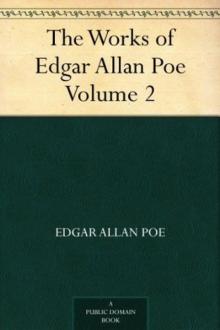 The Works of Edgar Allan Poe — Volume 2
The Works of Edgar Allan Poe — Volume 2 The Works of Edgar Allan Poe — Volume 1
The Works of Edgar Allan Poe — Volume 1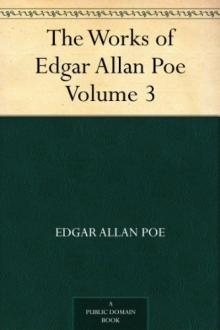 The Works of Edgar Allan Poe — Volume 3
The Works of Edgar Allan Poe — Volume 3 The Works of Edgar Allan Poe — Volume 5
The Works of Edgar Allan Poe — Volume 5 The Works of Edgar Allan Poe — Volume 4
The Works of Edgar Allan Poe — Volume 4 The Tell-Tale Heart
The Tell-Tale Heart The Raven (Penguin)
The Raven (Penguin) The Paris Mysteries
The Paris Mysteries Tales of Terror from Edgar Allan Poe
Tales of Terror from Edgar Allan Poe The Fall of the House of Usher
The Fall of the House of Usher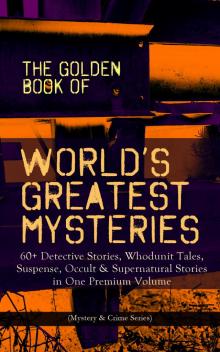 The Golden Book of World's Greatest Mysteries
The Golden Book of World's Greatest Mysteries The Narrative of Arthur Gordon Pym of Nantucket
The Narrative of Arthur Gordon Pym of Nantucket Ligeia
Ligeia The Landscape Garden
The Landscape Garden Complete Tales & Poems
Complete Tales & Poems Great Tales and Poems of Edgar Allan Poe
Great Tales and Poems of Edgar Allan Poe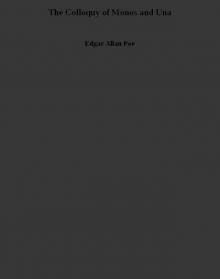 The Colloquy of Monos and Una
The Colloquy of Monos and Una The Oblong Box
The Oblong Box Thou Art the Man
Thou Art the Man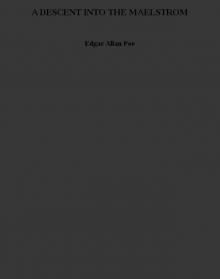 A DESCENT INTO THE MAELSTROM
A DESCENT INTO THE MAELSTROM THE MURDERS IN THE RUE MORGUE
THE MURDERS IN THE RUE MORGUE The Business Man
The Business Man The Mystery of Marie Rogêt
The Mystery of Marie Rogêt Metzengerstein
Metzengerstein The Man That Was Used Up
The Man That Was Used Up William Wilson
William Wilson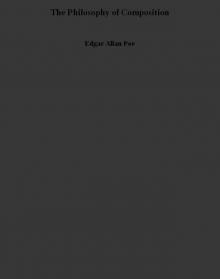 The Philosophy of Composition
The Philosophy of Composition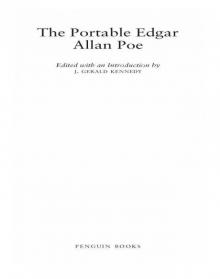 The Portable Edgar Allan Poe
The Portable Edgar Allan Poe Bon-Bon
Bon-Bon A Predicament
A Predicament The Premature Burial
The Premature Burial The Angel of the Odd
The Angel of the Odd The Man of the Crowd
The Man of the Crowd Never Bet the Devil Your Head
Never Bet the Devil Your Head The Tell-Tale Heart and Other Writings
The Tell-Tale Heart and Other Writings The System of Doctor Tarr and Professor Fether
The System of Doctor Tarr and Professor Fether Selected Tales (Oxford World's Classics)
Selected Tales (Oxford World's Classics) Essential Tales and Poems of Edgar Allan Poe (Barnes & Noble Classics Series)
Essential Tales and Poems of Edgar Allan Poe (Barnes & Noble Classics Series) MS. Found in a Bottle
MS. Found in a Bottle Some Words with a Mummy
Some Words with a Mummy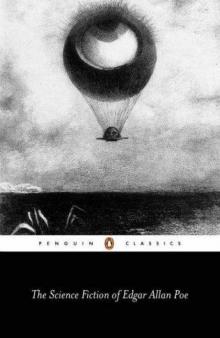 The Science Fiction of Edgar Allan Poe (Penguin Classics)
The Science Fiction of Edgar Allan Poe (Penguin Classics) King Pest
King Pest CRITICISM
CRITICISM How to Write a Blackwood Article
How to Write a Blackwood Article Mystification
Mystification Diddling Considered as One of the Exact Sciences
Diddling Considered as One of the Exact Sciences Steampunk Poe
Steampunk Poe The Literary Life of Thingum Bob, Esq.
The Literary Life of Thingum Bob, Esq. Classic Crime Collection
Classic Crime Collection Complete Stories and Poems of Edgar Allen Poe
Complete Stories and Poems of Edgar Allen Poe Berenice
Berenice The Black Cat
The Black Cat The Slender Poe Anthology
The Slender Poe Anthology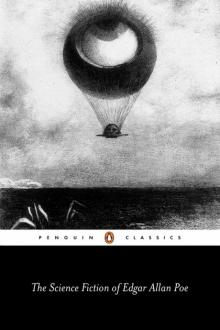 The Science Fiction of Edgar Allan Poe
The Science Fiction of Edgar Allan Poe The Assignation
The Assignation The Thousand-and-Second Tale of Scheherazade
The Thousand-and-Second Tale of Scheherazade The Raven and Other Short Stories
The Raven and Other Short Stories The Spectacles
The Spectacles Hop-Frog
Hop-Frog The Purloined Letter
The Purloined Letter Mellonta Tauta
Mellonta Tauta The Balloon-Hoax
The Balloon-Hoax Landor's Cottage
Landor's Cottage Mesmeric Revelation
Mesmeric Revelation The Pit and the Pendulum
The Pit and the Pendulum